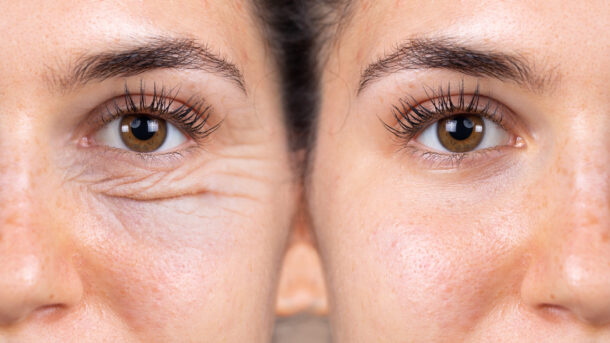Eye bags are a common concern for many, affecting not only appearance but also making people look tired and aged. Statistics show that about 60% of people over 30 are troubled by eye bags. This article systematically analyzes the causes, types, removal methods, and preventive measures of eye bags to help you restore youthful and bright eyes.

I. What Causes Eye bags?
1. Physiological Factors
- Fat accumulation: Orbital fat prolapses due to aging or genetics.
- Skin laxity: Collagen loss causes lower eyelid skin to sag.
- Poor lymphatic circulation: Staying up late and fatigue cause pseudobaggy eyes due to edema.
2. Lifestyle Influences
- Chronic sleep deprivation (disrupts microcirculation).
- High-salt diet (sodium retention causes edema).
- Excessive eye rubbing (accelerates elastic fiber breakage).
3. Irreversible Factors
- Hereditary eyebags (familial orbital septum fat prolapse).
- Bone structure (e.g., orbital depression worsens shadows).
II. Eyebag Types and Corresponding Solutions
| Type | Characteristics | Recommended Solutions |
|---|---|---|
| Edematous | Obvious in the morning, elastic when pressed | Caffeine eye cream + ice compress + lymphatic massage |
| Fat Prolapse | Persistent, obvious bulging | Endoscopic/transcutaneous blepharoplasty |
| Laxity-type | Skin sagging with fine lines | Radiofrequency tightening (e.g., Thermage) + collagen supplementation |
| Mixed-type | Combined fat prolapse and laxity | Comprehensive treatment (surgery + device assistance) |
III. 6 Scientific Eyebag Removal Methods
1. At-Home Care (for mild cases)
- Caffeine eye creams (e.g., The Ordinary, Shiseido Benefique Eye Contour Cream).
- Cold compress: Apply chilled spoons/tea bags for 5 minutes (constricts blood vessels).
- Massage techniques:
👉 Use ring finger to push from inner to outer corner (promotes lymphatic drainage).
👉 Press Jingming and Chengqi acupoints (10 seconds each).
2. Medical Aesthetic Light-Energy Treatments
- Radiofrequency tightening (Thermage): Stimulates collagen regeneration to improve laxity.
- Laser lipolysis (Fotona 4D): Non-invasive fat reduction.
3. Minimally Invasive Therapies
- Collagen/hyaluronic acid fillers: Suitable for “pseudoblepharoptosis” from orbital depression.
- Thread lifting: Lasts 1-2 years, ideal for early-stage laxity.
4. Surgical Solutions (long-term results)
| Procedure | Suitable for | Recovery Time | Longevity |
|---|---|---|---|
| Transconjunctival Excision | Fat prolapse with tight skin | 3-5 days | 8-10 years |
| Transcutaneous Excision | Severe skin laxity | 7-10 days | 10+ years |
| Orbital Septum Release | With tear trough depression | 5-7 days | Permanent |
IV. 3 Major Myths to Avoid
× Using hemorrhoid cream for eye bags: Contains irritants, may cause dermatitis.
× Self-needling for fluid release: High risk of infection and scarring.
× Blindly buying “fat-dissolving” eye creams: Ineffective for fat-type eye bags.
V. 5 Habits to Prevent Eyebags
Sleep Routine:
- Sleep before 23:00 + elevate pillow by 15° (reduces morning swelling).
Dietary Adjustments:
- Supplement vitamin K (spinach, broccoli) to strengthen blood vessels.
- Limit daily water intake to ≤2000ml (avoid drinking 2 hours before bed).
Sun Protection:
- UV rays accelerate collagen loss—use sunglasses + SPF30 eye-area sunscreen.
Proper Makeup Removal:
- Use cotton swabs instead of rubbing to avoid skin tugging.
Regular Care:
- Apply eye masks twice weekly (with peptide/hyaluronic acid).
Conclusion
Eye bags removal requires “targeted treatment”—mild cases can improve with lifestyle changes, while stubborn cases may need professional aesthetic solutions. Remember: prevention is better than cure—quit eye-rubbing and late-night habits today, and your eyes will reward you with brightness and radiance.



